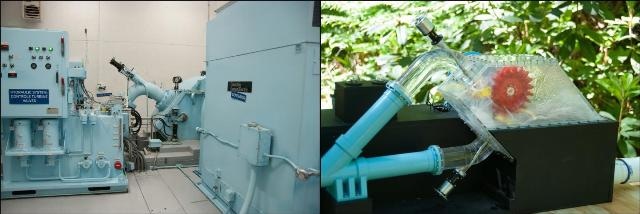Jul 1 2016
A unique computer modeling package that enables people to assess the capacity of a stream for hydropower has been designed by engineers from Oregon State University. This computer software can be used by people from any place in the globe. Generating electricity from a small-scale, “run of river” hydropower is a promising means for producing electricity in today’s world.
 This image shows both a model and a working small scale hydropower system in the central Oregon Cascade Range. (Credit: OSU)
This image shows both a model and a working small scale hydropower system in the central Oregon Cascade Range. (Credit: OSU)
The easy-to-use system does not need data that is mostly not available in remote areas or foreign countries. The system is capable of estimating the current hydropower potential by taking into consideration not only the present but also considering the anticipated changes in stream runoff and climate that can occur in the future.
Experts at OSU have confirmed that communities, agencies or individuals interested in knowing the small-scale hydropower development potential can do so with the aid of the system. They can access accurate information about hydropower potential with little effort, to determine whether their energy requirements of the present and the future can be met, using the system.
The results of the study, which was aided by the National Science Foundation, have been presented in Renewable Energy.
These types of run-of-river hydropower developments have a special value in some remote, mountainous regions where electricity is often scarce or unavailable.
Kendra Sharp, the Richard and Gretchen Evans Professor in Humanitarian Engineering in the OSU College of Engineering.
"There are parts of northern Pakistan, for instance, where about half of rural homes don't have access to electricity, and systems such as this are one of the few affordable ways to produce it. The strength of this system is that it will be simple for people to use, and it's pretty accurate even though it can work with limited data on the ground."
The field test for the new system was conducted in a small-scale hydropower facility, of 5-megawatt power, that was constructed in the 1980s. The facility is located at the central Oregon Cascade Range, on Falls Creek. The system projected that the site’s optimal electricity output will change from spring to winter and that the annual hydropower potential will go down due to the conditions that existed between the years 1980 to 2010.
Researchers note that due to its cost-effective and simple technology that does not need large reservoirs or dams, small-scale hydropower continues to be a viable option for electricity generation. The impact of the technology on the environment, on the stream’s ecosystem and on fishery, though unavoidable is very minimal, too. Moreover, hydropower is a renewable source of electricity and does not emit any greenhouse gases.
A holding basin is one of the simplest forms of diverting water. With a self-cleaning screen, the basin can prevent fish, insects, unwanted objects and debris from entering the set-up. The water thus diverted is passed through a turbine that is installed on a lower elevation and then released back into the stream.
The efficiency of technology used is affected by various factors such as the drop in the water or “head height,” among others. However, the seasonal impacts can be compensated for if proper regulations are put in place to maintain the required minimum stream flow.
Many of the tools that were designed to assess the small-scale hydropower potential in the past take into account data that is mostly unavailable in developing nations and are not capable of taking into consideration future changes in climate and weather, said the researchers.
Thomas Mosier, who was a graduate student at OSU at the time of research, collaborated with David Hill, an OSU associate professor of coastal and ocean engineering and Sharp to develop the free, open source software program.
The researchers have stated that the system will help policy makers and engineers worldwide to make informed decisions on hydropower investment and development.